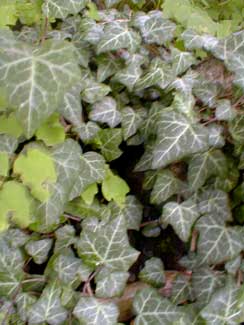
Can English Ivy Injure
the Trees it Climbs?
"Ivy usurps the laurel's place of growth."
-Lord Byron
1788-1824
1788-1824
This September photo shows a sturdy evergreen English Ivy with arrow-shaped leaves, the central of three lobes biggest, each leaf in the inch & a half to two-inch range, a mid-green with cream veins. I don't know what variety of dwarf ivy this may be, so I've labeled it somewhat generically as Hexandra helix forma minima. In this photo a few leaves of Vancouveria hexandra intrude.
It is spreading in a dry shade garden more rapidly than three other dwarf ivies in the same general vicinity, covering part of a rock wall. It is beginning to climb a hawthorn tree & I do not intend to restrain it from doing so.
A healthy tree in general cannot be harmed by ivy clinging to the trunk. The clinging-roots do not burrow under the bark, do not draw nutrients from the tree, do not strangle the tree. By compared to, say, climbing hydrangea or clematis, there are some potential hazards from ivy, especially if unrestrained.
Ivy can over time add so much weight to a tree that it increases the possibility of breaking loose bark. If it is not restricted to the trunk, but has spread out into the canopy, it increases the chance of blow-down in high winds, & especially in stormy areas adds risk. Ivy also increases limb loss in high winds. Ivy heightens these risks by increasing the tree's wind resistance. It is recommendable to remove at least any ivy that climbs away from the trunk, as that which clings to the trunk per se does not increase wind resistance. Ivy that has spread into the canopy can out-compete the tree for sunlight.
Ivy can hide tree-killing infestations, funguses, & diseases that are treatable if spotted in time, but won't be spotted beneath the ivy. Trees that are already ill or near the end of their lives, but which might have had a decade or so of attractive life left in them, may have their time shortened by ivy, by harboring bacterial disease or by providing a haven for increasing numbers of insects, some of which are harmful to trees. Ivy that is doing especially well in a tree can be an early sign that the tree is in decline, & the ivy can hasten the development of disease, but it is not the cause of the sickness.
Though ivy does extremely well in shade, it in general only produces flowers & seeds when in full sun, & so seeks to get out of the shade by climbing trees. It is especially fond of climbing dying trees, because aging or sickly trees produce fewer leaves, permit more light through, which the ivy likes. Often ivy is seen thick upon a dead tree & it can look as though the ivy must've killed the tree, but the ivy was merely an opportunist seeking to get more sun.
English ivy is an invasive competitor harmful to our native forests, though only if it begins to flower & seed. In order to flower, parts of the ivy must go through genetic change which occurs only in bright sun. An undergrowth of ivy in deep shade rarely if ever goes through the metamorphosis required to produce flowers then seeds which birds scatter into native woodlands. But ivy that has reached the upper canopy of a tree & is in full sun frequently develops upright "bushy" parts that poke straight up out of the canopy like little trees on top of a big tree. This is the part of the ivy that will flower, & will be too high up to keep them from going to seed, & only then poses a threat to native woodlands. For this reason all flowering ivy should be removed from the garden, but it probably won't even be noticed in the tree canopy.
Of course, if you live in England where ivy grows native, this is not an issue, as excess ivy in declining trees is intrical to the native environment, providing one of the preferred habitats for sundry species of birds, bats, squirrels, etc. In England it is illegal to damage or interfer with bat roosts, including trees with lots of ivy. But here in the northwest where ivy is not natural to the forests it invades, programs have been undertaken to remove English ivy which eradicates sensitive native species in its path, & many of our region's landscapers have "taken the oath" never to plant what has become an invasive pest. Dwarf & variegated ivy cultivars are not invasive, but large-leafed plain english ivy should not be planted or preserved.
Although I've outlined a few things to worry about when ivy really gets strongly established up a tree, in general even a slight possibility of harm can be avoided by planting only dwarf varieties. If a gardener avoids planting large-leaf standard ivys & sticks to ornate dwarf varieties, the possibility of undue extra weight & increase of wind resistance & competition for sunlight will be far less significant to any tree the tinier ivys climb.